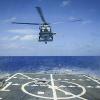Leaderboard
Popular Content
Showing content with the highest reputation on 10/09/2016 in all areas
-
1. Too many players with too many "Red Flag-isms" (i.e. self-inflicted pile-ons to 11-214). I've been to 6 RF-A and 2 RF-N. The one's at Alaska are far better because they don't try to jam way too many jets in the airspace and they use 11-214/don't arbitrarily add on. I get it that we want to get everyone a swing at the bat, but the training factor is very watered down when you have a 20 ship SEAD package where 8 will do (as an example). It is deconfliction flag to an extent - and that is not good tactical training. Mitigate this by allowing less squadrons (may not be possible, I get it) and/or potentially lengthening vuls to allow multiple pushes....or instead of one long vul, do 2x back to back morning vuls and 2x back to back afternoon vuls. 4 vuls a day, but close enough that it really is 2x goes for MX, just with 45 min in between launch of one 4 ship and the other. Debrief each separately so the first guys aren't waiting another 1-2 hours for debrief to start. Run the debrief efficiently - stick to timeline limits, shot val rules, etc...you miss a shot by > 10", fuck off we're not going back. 2. Brecky hit PR - the CAF sucks ass at PR...probably the thing the CAF should be the most embarrassed about it's lack luster performance in...and I'm looking at every fighter pilot out there, I don't care what you fly, you have a role in supporting PR events, so put some damn work into supporting the PR plan, not being a shitty/useless OSC, etc. A pre-planned PR vul can speed things along to not drag out a training vul, but real time shoot downs can at least exercise initial OSC/AMC duties, and the pre-plan can be the next day to get that guy (i.e. for range time you can't shoot a guy down 30 min into vul west of the container and have Pedro push from El/Cal, I get it). No tanker - shit happens, wave the "ALR exceeded, I'd abort in real life" card and then go execute for training. Copy all, it'll be 2x60s and some Sandys against the world...and they'll probably get shot, but there's still training to be had. 3. Focus on basic integration in OCA/DCA/DT vuls. Johnny CAF isn't going to solve the F2T2EA problem for ALRS, in fact, he's going to fuck up the mission planning whole sale and lead an abortion the next day. That's not his fault - in real world, he'll be handed a plan, and he won't be the guy leading the whole thing anyways. Leave "next gen" problem solving to WIC advanced integration phase. Let the CAF figure out how to put a cohesive plan together that defeats the Nellis IADs, destroys appropriate-to-the-scenario targets, and gets everyone back home. I agree the threat level needs to be increased, but the point is basic integration...it is trying to do too much and has negative effects when we try to force the "WWIII" problems on the line CAF guy. There's a reason not every CAF dude is read into CW, etc...he doesn't need to be, the right people need to be who will be planning/have a unique understanding of the capabilities and can leverage those with their squadrons come execution day. 4. Airdrop guys - If they're not getting enough LFE training (are you guys really being left out of RF-N that much?), get them in there. It's not difficult to add an air assault, SOF resupply, etc. into a couple OCA vuls per week. I'm not saying it needs to be a full on JFE vul, but at least get a couple MAF/AFSOC assets doing a resupply on the west side of Belted or something along those lines. It'll be great training for them, but also for the SEAD and ESC guys who have to keep SA on a C-130 at 300 ft, protect him, and have a gas/TOS plan to not lose coverage. And at worst, the C-130 does its mission, there is zero interference with the rest of the war raging overhead and if he gets shots, well there's going to be some good lessons learned for the CAF guys who probably didn't have a good plan to begin with. To minimize the "everyone gets a trophy" thing, don't do MAF and PR in the same vul. Watch out for that dick head Roland guy. 5. Three weeks is long - but if you keep doing three weeks, consider making the third week dissimilar BFM/ACM week. When that square peg doesn't fit the round hole of airspace scheduling, etc. for every jet out there, make some CT-ish DCA vuls, i.e. smaller vuls where nobody is doing a MC upgrade, you can have a North and South vul, etc. Northern Edge in AK does a lot of this...i.e. first vul of the day is the WWIII problem, second vul is all CT. Some squadron gets tagged for MC, they're given the assets and range space/time, go from there to plan/execute whatever you want within some constraints (for safety, etc.) Airboss can make sure it doesn't get out of hand/go down some road it shouldn't. There will still be a lot of learning, but with less of the "RF bullshit" attached, and everyone is less "burned out" at the end.3 points
-
We already have several platforms shooting a ~$22K weapon...fairly cheap way to kill shitheads/Hilux in comparison to the other precision guided options. The current manned and unmanned ISR doing the HVI hunting/killing mission are very good at it. The only thing missing right now is faster transit speed, but it's only a matter of very little time until we field an RPA that can do 350 kts in transit, problem solved. I'm not so sure the proverbial we aren't trying to solve a problem that doesn't really exist. I don't see us not completing the kill chain because of a lack in capability from an MQ-9, U-28, etc. What is going to change if we introduce something additional? Because the number in the win column is pretty large, and I think the only major, limiting factor on its rate of growth is asset availability, not a large capability gap.2 points
-
I guess I just disagree with the OP on the "observation" role being that unique or really necessary. A lot of the fighting that the light attack aircraft could accomplish isn't in direct support of a boots-on-the-ground groundforce. Tons of work in Iraq/Afghanistan/Somalia/Yemen/Libya/Philippines/Mali/Burkina Faso/et al could be done where the U.S. has little to no ground presence. And if/when we do have boots on the ground, it's not cosmic or unheard of to chop an air asset to that specific ground element, especially if they're playing for one of the varsity squads. I also disagree that current multi-sensor ISR isn't being used as an "organic part of the ground maneuver element," I've done it personally - TACON to a particular GFC for an extended period of time. All the pluses gained with familiarity and building relationships, although in a large theater, that's not a particularly efficient way to utilize a $10-15m+ asset. Finally, I disagree that sending FMV + metadata BLOS to a JOC makes you a "voice-directed RPA;" not if you're doing it right and have the trust of the GFC, the FSO and their ITCs. So basically I don't see a whole lot of "newness" in what OA-X is supposed to accomplish per Pako's article linked in the OP. I've see a lot of forced novelty from the patch/DARPA/PhD set because those guys are basically required to come up with dissertations that break new ground, it's the same problem academia has writ large. Not every budding Professor of Air Warfare with multiple patches on his shoulders actually thinks up something new and important, although they're required to write as if they had. OA-X should be a lowish-cost way to combine some of the best aspects of the MQ-9, U-28, and fast-movers. A crew aircraft with lots of radios/datalinks/sensors/weapons that still has legs and multi-int fusion capability that can be flown for less than an arm and a leg per hour would have done a lot of good over the last 15 years and would do a lot of good going forward. The above-mentioned aircraft all have pieces of that puzzle - this platform I think would just consolidate and give commanders a 1-stop shop that doesn't have the some of the same limitations of the others. BL: we don't have to reinvent the wheel, just combine a few things that already work into one platform and unleash it on all the assholes populating the garden spots of the world.2 points
-
Update the EW range. Reduce the number of players. Make the scenarios more about basic integration with other platforms than trying to solve WW3 with poor assumptions and invalid lessons learned. In other words, go back to the roots of why RF was started. Solving WIC level scenarios with a group that typically doesn't even have the deconfliction solved by the final coord isn't the way to go.2 points
-
We're looking for a new pilot or two. All interested individuals are invited to send their resume and/or information to 122FSpilothiring@gmail.com . A full application includes, but is not limited to, a college degree or status of coursework/transcript, AFOQT scores, TBAS test and PCSM score, and summary of flying time, if any. All applications will be considered, but only a small number of applicants will be invited to interview in January. I highly recommend visiting during one of the upcoming drills (Oct 14-16, Nov 4-6, Dec 2-4). If you want to maximize your chances make sure all the tests are complete with competitive scores (most of our applicants that get interviews have scores in the 90s) and you are within a semester of college graduation. It also helps if you visit (and don't get hammered and make a fool of yourself - I mention it because it happens). Questions? Shoot an email to the address above. Good luck everyone, we're looking forward to finding our next round of Eagle drivers.1 point
-
Fair enough, disagreement is healthy. When all the talk is only in one direction, we never step back and evolve if appropriate. I think I understand what he is trying to get across with his article on articulating the concept of "Observation" and I echo your point on military academia publishing for fear of perishing, those papers are not always worth it... It should be a one stop shop for ISR, PED, Comm, Light kinetic, etc... and the key is for it to be in one right sized platform that doesn't need AR, doesn't need to be cued from another sensor platform necessarily, has some legs but doesn't try to match an RPA in persistence and can deliver a right sized kinetic effect without putting itself into the WEZ of likely to encountered threats... all this without breaking the bank in operational cost, development risk and acquisition. Commuter turboprop in the 19-30 passenger range or repurposed small MPA would be my suggestion. Keeps cost in the 2k or less per flight hour, acquisition likely in the 25 mil or less range and enough capacity for all the gear without having to finagle it and some room for growth in weight, power required, etc. The distinction has to be made in who is controlling the mission and how big the information loop is, does the ITC need to be in it? Rhetorically asked but I think that is one of the questions inferred by the OP article. Build a family of systems to fight this war Big Blue rather than showing up with hardware too expensive to operate in these persistent, long marathons to keep the barbarians from over running the tenuous at best governments we support, rightly or wrongly. CSAF believes we are in for another 15 years of this, plan accordingly. AT-6B, A-29 or Scorpion for LAAR. OA-X for LASO (Light Attack, Surveillance & Observation). MQ-9 ERs for extreme persistence ISR / surgical strike. Everything can do ISR / Observation, everything can strike, everything is relatively cheap to operate.1 point
-
Seems to be true. I just learned that an old Academy squadron mate was picked up for Major on his 5 ABZ board. Sent from my iPad using Baseops Network Forums1 point
-
While everyone is day dreaming about cheap planes. Don't forget to dream up some cheap munitions.1 point
-
Follow 11-214 (i.e, don't add on to it) (e.g, dynamic weapon deconfliction and block adjustment for unexpected weather not allowed even though IAW 11-214) More training for white force. If you don't "have" some information and you are withholding it to drive a DLO, recognize when to end the tailspin of planners/intel trying to dig into it and tell them "I can't give you target composition for the airport at Hiway since we have escort DLOs for there", etc. Expand airspace access as much as DoE allows. No changes post - final coord unless necessary for safety of flight (don't change the deconfliction plan just to satisfy a VMC international player) Make the security paperwork more efficient - kills learning when 50% of your squadron can't go to some meetings and briefs1 point
-
And just so I'm not just asking for answers/recommendations without having thought of some of my own: - Renovate/expand the current POS building. Too small, not nearly enough vault space, and well past its expiration date. If Big Blue wants learning to occur, there has to be an adequate classroom for all involved and at the appropriate classification levels. - Provide realistic and enough adversaries to replicate something past the 1990s threats. The current "Red Air" tax is negative learning for both the affected players and the vul's Blue Forces. Not a fan of the barely third generation rental adversaries idea. Not the guys, but the equipment itself. Not to mention the dearth of ground emulators. Obviously, my thoughts run more along the resources line rather than tactical, but all of it needs to be looked at.1 point
-
The setups are far to canned...Move the Red Air Tanker...nothing like a fist fight all the way west just to have Red literally roll inverted off the boom and call a kill on you 30 seconds later.1 point
-
I agree with a lot of what you're saying, except this notion that being an ADO (at whatever rank) is good for the career--at best you break even in that posistion. ADO is at best a holding pattern while you wait for a more legitimate job/better PCS to open up, and often the ADO office is just a place to put guys who aren't able to do much else career wise, regardless of the rank. Don't get me wrong, it's an awesome place to be if you just want to fly the line and help mentor the young guys (which is very important), but it's not some type of box that needs to be checked if you have higher career goals. I've heard this thought (i.e. I need to become an ADO because of reason X) among the younger guys in the squadron level over the past several years and this needs to be understood for those who are trying to get to the next level. But like I said, if someone just wants to fly and help out the squadron and the younger guys, then that's cool too. Either way, just know how you're playing the game. YMMV.1 point
-
Meh, We're dropping multiple GBUs/Hellfires to kill a dude getting paid 200 dollars to dig a hole and bury HME. A GBU-10 for a MI series is probably a bargain by comparison. Sent from my iPhone using Tapatalk1 point
-
This thread.... It's good to know the one universal in all branches of the military when it comes to aviation is reminding everybody how your selection was the right one and theirs was stupid.1 point
-
Just made the gold to silver transition this year. I did not have to go through again. The JPRA sets the Level C training standards, so the Navy and AF have to meet the same requirements.1 point
-
If it is a short term, Big Safari program, likely it will be contract maintenance. This gets the system up quicker and doesn't require allocated manpower. If the program were to last long enough/get big enough, blue suit maintenance might become a player. Examples: MC-12 was contract maintenance. MQ-1/9 began as contract maintenance, and eventually blue suiters were added (not sure if there are still contract maintainers, or if it eventually went 100% blue suit).1 point
-
You being an expert on both subjects, I'll take your word for it.....besides, its midget porn featuring Del Rio midgets. Sent from my iPhone using Baseops Network Forums1 point










